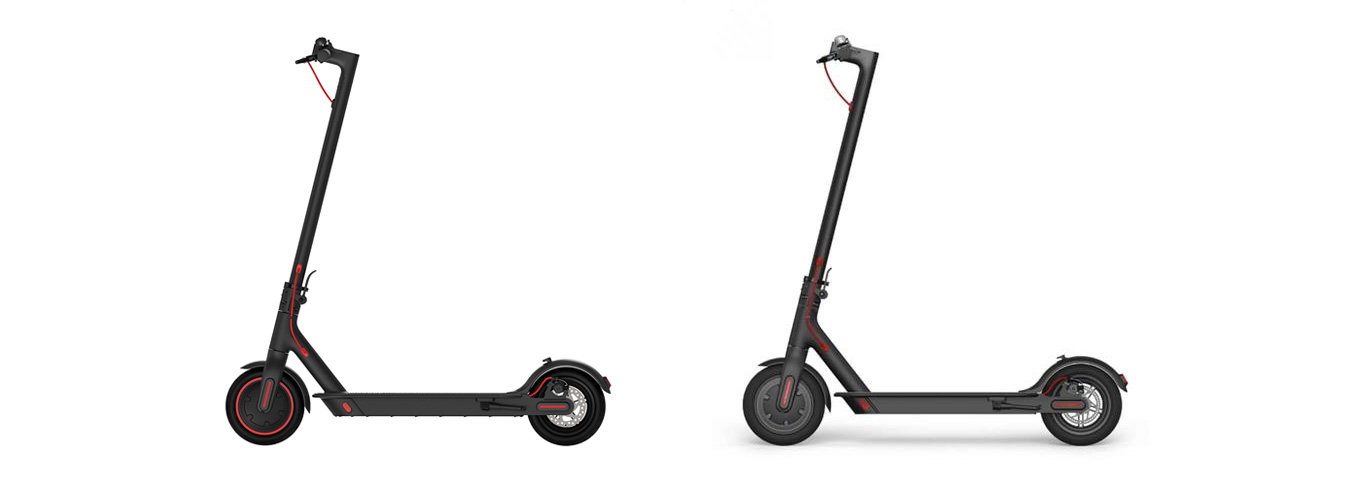Xiaomi just released its new e-scooter Xiaomi Scooter Pro. It got a lot of interesting new features, for example a display which was one of the items where M365 lost against Ninebot ES2 in my Xiaomi M365 vs Ninebot ES2 comparison. It got a larger capacity battery for increased range & a stronger motor, so let’s check out the new features:

Xiaomi M365 Pro vs Xiaomi M365 – Main Specs
-
Xiaomi M365 Pro
- max. speed: 25 km/h
- range: 45 km
- weight: 14,2 kg
- battery: 474 Wh
- charging time: 8,5 h
- motor power: 300W (600W peak)
- tires: air tires
- suspension: no
- brake front: electrical
brake rear: mechanical - display: yes
- max. gradient: 20%
-
Xiaomi M365
- max. speed: 25 km/h
- range: 30 km
- weight: 12,7 kg
- battery: 280 Wh
- charging time: 5,5 h
- motor power: 250W (500W peak)
- tires: air tires
- suspension: no
- brake front: electrical
brake rear: mechanical - display: no
- max. gradient: 14%
Box Contents
The box content of Xiaomi Scooter Pro is comparable to the Xiaomi M365. It comes almost fully assembled you only have to attach the handle bar, screw and wrench are included. You’ll receive charger and an adapter to inflate the tires. I’m currently not sure if there will be an EU version with extra tires, like for the M365.
Design & Parts
Frame
The weight of Xiaomi Scooter Pro is 14.2 kg, which is 1.5kg more than Xiaomi M365. That’s mainly because of the larger capacity battery. The battery is stored under the footstep which I prefer as it offers a better driving experience with its lower center of gravity compared to Ninebot ES2 where the battery sits in the handle bar. Below the footstep there’s a foldout stand to sturdy park your scooter. The footstep of Xiaomi Scooter Pro is a bit longer and wider than M365 allowing a more comfortable ride.
Xiaomi M365 folds within seconds, the mechanism sits between steering bar and footstep. The crossbar connects to the cover of the back wheel to easily carry your scooter which feels well balanced. It was advertised that there is an improvement with the folding mechanism although it seems to be the same as on Xiaomi M365. I guess only long term tests will show if this weak spot from Xiaomi M365 really improved!

Folding Mechanism: Xiaomi M365 (left) vs Xiaomi Scooter Pro (right)
Motor
The front wheel holds a 300W (600W peak) motor which is a plus of 50 W compared to Xiaomi M365 (550W peak). Max. speed is stated with 25km/h which is comparable to the non-Pro version. But it is stated that the new Pro model is capable of climbing steeper hills with 20% gradient. While there were 2 modes offered on Xiaomi M365 (25 km/h normal and 18 km/h Eco mode), the new Xiaomi M365 Pro will offer 3 modes: Energy Saver mode ECO: 15km/h, Standard mode D: 20km/h, Sports mode S: 25km/h.
Battery
The built in battery of Xiaomi M365 Pro offers a capacity of 474 Wh compared to the 280 Wh capacity of Xiaomi M365. As mentioned the battery sits below the footstep of the scooter. With this upgrade the max. range of the Pro model should be 45km (compared to 30km of M365). The 30km stated range of M365 turned out to be about 25km in real life. First test show that there is an extended range, but it’s hard to measure.
LEDs & Display
Xiaomi M365 Pro holds a display which shows all the scooter’s parameters. After testing Ninebot ES2 the display seemed to be very convenient and I was missing this item on my Xiaomi M365. The display shows current speed, the selected mode: ECO for energy saving mode (15km/h), D for standard mode (20 km/h) and S for sports mode (25 km/h). It also indicates if lights are turned on and Bluetooth connection is active. Below there are warning infos if maintenance is needed and on the bottom the battery status.
Same as M365 the Pro version offers a bright LED headlight, a red rearlight and comes with a bell.

Xiaomi M365 Pro – Display & LED lights
Tires & Brakes
Xiaomi Scooter Pro and Xiaomi M365 are fitted with tube air tires instead of solid rubber tires found on Ninebot ES2. This offers advantages and disadvantages. I prefer tube air tires as they offer a smoother ride compared to the solid tires of Ninebot ES2 (which even has suspension). Of course they can deflate or puncture, but still I think the experience is better.
Xiaomi Scooter Pro offers the same two separated brake systems as M365: Integrated in the front wheel there is an eABS, regenerative anti-lock braking system. When you release the accelerator lever, the front wheel slowly brakes and the generated energy flows back into battery. The back wheel holds a 120mm disk brake which is activated with the brake handle on the steering bar.

Xiaomi M365 Pro – Tires & Brakes







